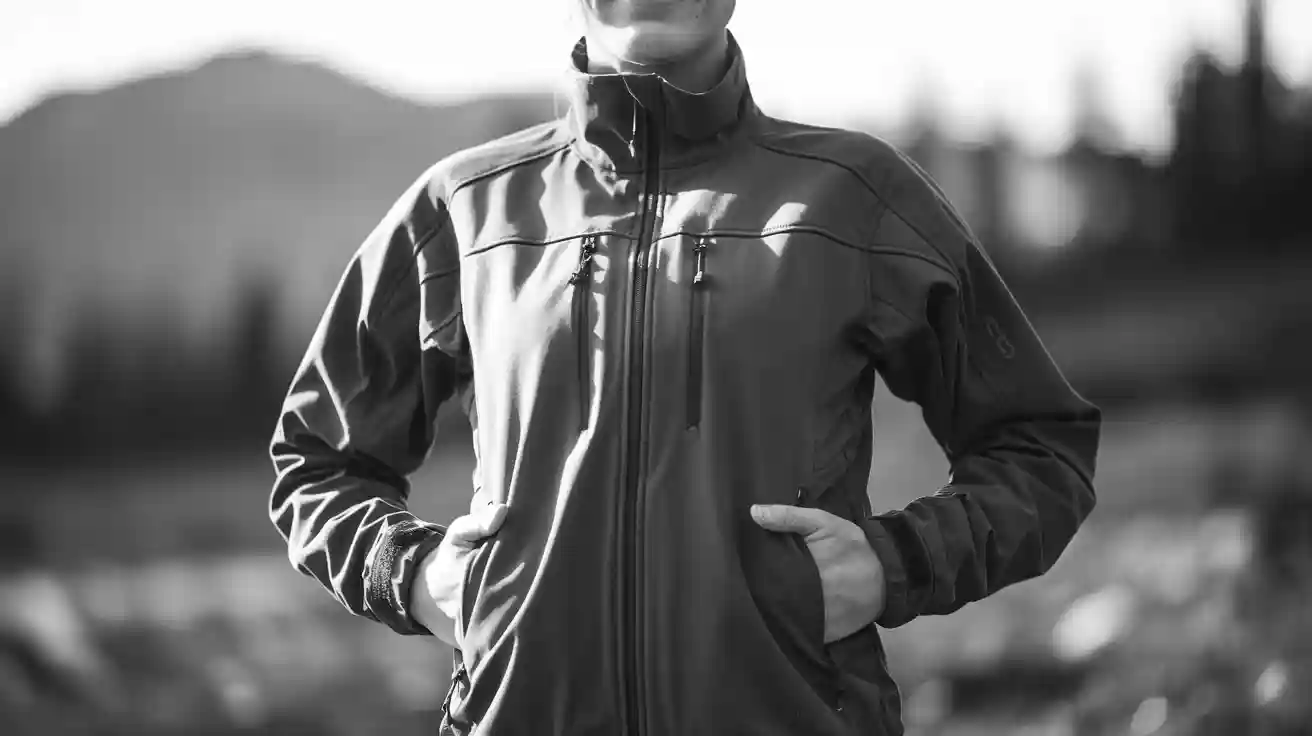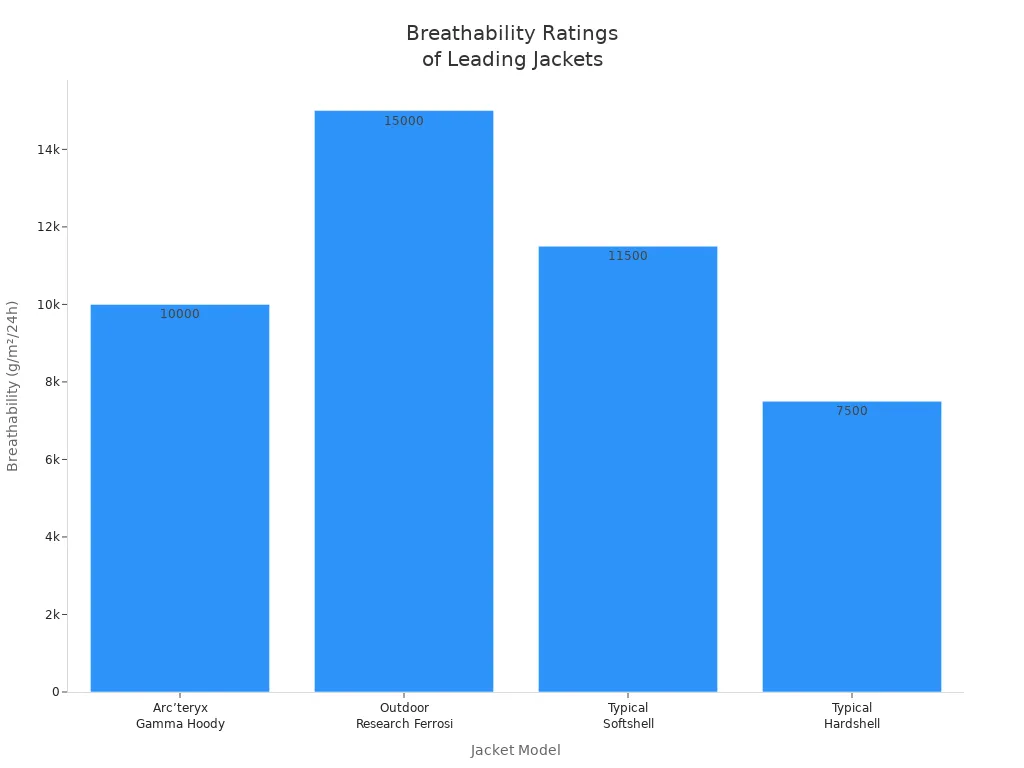Softshell jacket

A softshell jacket uses advanced, flexible fabrics that offer comfort and mobility. Unlike traditional outerwear, a softshell jacket combines breathability with water resistance, making it stand out for active lifestyles. Many people choose a softshell for hiking, climbing, or skiing because it balances protection and movement. Over the past decade, the softshell jacket has gained popularity as more people join outdoor activities and seek versatile clothing. Improvements in fabric technology have made the softshell a favorite for both outdoor enthusiasts and those who want reliable daily wear.
Основные выводы
- Softshell jackets use stretchy, breathable fabrics that balance comfort, flexibility, and moderate weather protection.
- They offer excellent mobility and comfort, making them ideal for active outdoor activities like hiking, climbing, and skiing.
- Softshells resist light rain and wind but are not fully waterproof; layering is needed for harsh weather.
- These jackets are versatile for many uses, working well as outerwear in mild weather or mid-layers in cold conditions.
- Choosing the right fit and caring for the jacket properly helps maintain its performance and durability over time.
What Is a Softshell Jacket

A softshell jacket is a type of outerwear designed for active people who need comfort, flexibility, and moderate protection from the elements. This jacket uses advanced softshell fabric that combines stretch, breathability, and water resistance. Unlike heavy winter coats or rain jackets, a softshell jacket offers a balance between warmth and movement. People often choose a softshell for outdoor sports, travel, or daily wear because it adapts well to changing weather and activity levels.
Softshell Jacket Materials
Softshell jackets rely on a blend of synthetic materials to achieve their unique performance. The most common softshell fabric includes:
- Polyester: Adds durability, breathability, and helps manage moisture.
- Nylon: Increases strength and abrasion resistance.
- Elastane (Spandex): Provides stretch for better mobility.
Manufacturers often treat the outer layer with a Durable Water Repellent (DWR) coating. This treatment allows water to bead up and roll off the surface, keeping the wearer dry during light rain or snow. The inner layer may use brushed polyester or fleece for added comfort and light insulation. This combination of materials makes the softshell jacket ideal for high-energy activities, as it balances breathability, flexibility, and moderate weather protection.
Совет: Softshell fabric does not make the jacket fully waterproof. It works best in mild to cool conditions where breathability and movement matter most.
Construction and Design
The construction of a softshell jacket sets it apart from other types of outerwear. Softshell jackets use woven, stretchy softshell fabric that allows for a close fit without restricting movement. Many designs feature a three-layer structure:
- Outer Layer: Durable polyester or nylon with a DWR finish for water resistance.
- Middle Layer: Sometimes includes a breathable membrane for extra wind and water resistance.
- Inner Layer: Soft brushed polyester or fleece for comfort and light warmth.
This design makes the softshell jacket flexible and comfortable, with enough protection for most outdoor adventures. The jacket often includes features like adjustable cuffs, zippered pockets, and high collars to block wind.
To understand how a softshell jacket compares to other jackets, see the table below:
| Jacket Type | Construction Details | Material Characteristics | Functional Properties |
|---|---|---|---|
| Софтшелл | Woven, stretchy synthetic fabrics (polyester, nylon, elastane), often DWR treated. | Durable nylon or polyester face fabric with soft brushed polyester or fleece interior. | Flexible, breathable, water-resistant (not waterproof), wind-resistant, prioritizes mobility. |
| Hardshell | Multi-layered: outer textile with DWR coating, waterproof breathable membrane, inner lining. | Durable, stiff materials laminated for waterproofness and windproofing. | Highly waterproof and windproof, less breathable and flexible, designed for harsh weather protection. |
| Флис | Made from soft insulating microfleece fabrics. | Soft, cozy fabric without water or wind resistance. | Provides warmth and comfort but lacks significant weather protection. |
A softshell jacket stands out because it uses softshell fabric to deliver a mix of comfort, stretch, and moderate weather protection. Hardshell jackets focus on maximum waterproofing and windproofing but feel stiffer and less breathable. Fleece jackets offer warmth and softness but do not protect against wind or rain. The softshell jacket fills the gap, making it a top choice for people who want versatility and comfort in one garment.
Benefits of a Softshell Jacket
Comfort and Mobility
Softshell jackets deliver outstanding comfort and freedom of movement. Designers use four-way stretch fabrics that allow the wearer to reach, bend, and twist without restriction. This flexibility supports activities like climbing, hiking, and skiing, where a full range of motion is essential. The softshell material feels softer and less crinkly than hardshell jackets, which adds to the comfort during movement on trails, rocks, or ski tracks. Testers often report that the fit and comfort of these jackets suit many body types and preferences, making them a top choice for active use.
Softshell jackets use stretchy panels under the arms to improve both mobility and breathability. This design allows for a snug fit that does not limit movement, enhancing comfort during high-output activities.
Consumer surveys show that users rate the comfort of softshell jackets highly. The table below highlights user ratings for several popular models:
| Jacket Model | Comfort Highlights | Comfort Limitations | User Rating |
|---|---|---|---|
| The North Face Apex Bionic 3 | Comfortable for long wear; soft fleece lining; good fit; windproof | Breathability issues during high activity; less suitable for extreme cold | 7.4 / 10 |
| Arc’teryx Gamma LT Hoody | Light, very comfortable; excellent mobility; breathable during intense activity | Hood size issues; less protection in extreme weather | 8.2 / 10 |
| Marmot ROM GTX Infinium Hoody | Cozy fit; soft interior; allows brisk movement; durable | Snug fit around waist for some users | 8.2 / 10 |
| Rab Kinetic 2.0 | Highly comfortable fit; impressive breathability | Minimalist design may not suit all | 8 / 10 |

Softshell jackets stand out for their lightweight feel and low weight, which reduces fatigue during long days outdoors. The combination of comfort, breathability, and freedom of movement makes them a favorite for anyone seeking high performance in active settings.
Weather Protection
Softshell jackets provide reliable weather resistance for a wide range of outdoor conditions. The outer fabric often features a durable water repellent finish, which helps shed light rain and snow. While not fully waterproof, these jackets offer enough water repellency for short showers or damp environments. Laboratory tests show that softshell jackets like the Rab Borealis deliver minor to moderate wind resistance and dry quickly after getting wet. However, they require layering with other garments for improved protection in harsh weather.
Softshell jackets are best for cold weather and cool, dry conditions. They offer moderate insulation, making them suitable for temperatures below 10°F, especially when paired with other layers. In transitional seasons such as spring and fall, a softshell jacket can serve as a standalone piece, providing warmth and breathable weather protection. The lightweight option and fast-drying nature of the fabric help maintain comfort during changing weather.
Note: Softshell jackets are not the best for wet weather. Hardshell jackets provide superior waterproofing and windproofing, especially in heavy rain or snow. For multi-day trips or when heavy precipitation is expected, a hardshell is recommended.
Softshell jackets excel in breathability, which prevents overheating and moisture buildup during high-energy activities. This balance of warmth, weather resistance, and breathability makes them a practical choice for outdoor enthusiasts who value performance and comfort.
Versatility
The benefits of a softshell jacket extend to a wide variety of activities and environments. Outdoor athletes and adventurers choose softshells for hiking, backpacking, climbing, trail running, mountaineering, biking, and winter sports like ski touring and snowshoeing. The combination of flexibility, breathability, and lightweight construction supports performance in aerobic and sweat-inducing pursuits.
Softshell jackets adapt well to different climates and activity levels. In cold weather, they work as effective mid-layers under heavier coats. During spring and fall, they provide enough warmth and weather resistance to be worn alone. Their low weight and packability make them easy to carry, adding to their appeal as a lightweight option for travel or day trips.
The freedom of movement and comfort offered by softshell jackets make them suitable for both outdoor adventures and everyday wear. Many people appreciate their stylish designs and practical features, such as zippered pockets and adjustable cuffs. The performance of a softshell jacket ensures that users stay comfortable and protected, whether on a mountain trail or in the city.
Softshell jackets are not the best for wet weather, but they shine in cool, dry, or mildly damp conditions. Their versatility, warmth, and breathability make them a smart investment for anyone seeking reliable, lightweight outerwear.
Best Softshell Jackets Features

When searching for the best softshell jackets, buyers should focus on features that boost performance and comfort. The most important qualities include breathability, weather resistance, and durability. Many high-end models use advanced fabric technologies to improve technical performance and style.
Дышащие свойства
Breathability sets the best softshell jackets apart from other outerwear. These jackets use fabrics that allow sweat vapor to escape, keeping the wearer dry during high-output activities. Softshell jackets often outperform hardshells in this area. For example, the Arc’teryx Gamma Hoody has a breathability rating of 10,000 g/m²/24h, while the Outdoor Research Ferrosi reaches 15,000 g/m²/24h. Most leading softshells fall between 8,000 and 15,000 g/m²/24h, which is higher than typical hardshell jackets.

Softshell jackets use nylon-spandex blends or polyester with DWR coatings to enhance vapor diffusion. Ventilation features, such as pit zips or mesh panels, can improve airflow by up to 20%. This level of breathability makes softshells ideal for aerobic activities like hiking, biking, or ski touring.
Water Resistance
The best softshell jackets offer reliable weather resistance for changing conditions. While not the best for wet weather, these jackets use a water-resistant shell and DWR treatment to shed light rain and snow. Advanced technologies like Gore-Tex, eVent, and Marmot MemBrain balance water repellency with breathability. Some models use Power Shield Pro or Windbloc for extra wind and water protection.
| Fabric/Technology | Key Properties and Uses |
|---|---|
| Gore-Tex® | Waterproof membrane, breathable, keeps dry in wet conditions |
| eVent® | Direct venting waterproof fabric, quick moisture escape |
| Polartec® | Breathable, thermal efficient, insulation, moisture escape |
| Marmot® MemBrain® | Balanced waterproofing and breathability |
| PrimaLoft® | Synthetic insulation, water-resistant, lightweight |
Softshell jackets provide effective water resistance for up to 30 minutes in light to moderate rain. They also block wind up to 20 mph, making them suitable for most outdoor adventures.
Долговечность
Durability is a key factor in the best softshell jackets. High-quality models withstand abrasion from rocks, gear, and rough terrain. Tests show that jackets like the Black Diamond Dawn Patrol Shell and Arc’teryx Trino SL Hoody resist snags and scratches, even after exposure to crampons and ice axes. Premium fabrics such as Teslin and reinforced nylon add to the jacket’s lifespan. Budget options may offer heavier materials but usually lack the same level of performance and weather resistance.
Tip: Choose a softshell jacket with reinforced shoulders and elbows for extra durability during backpacking or climbing.
The best softshell jackets combine breathability, weather resistance, and durability to deliver top performance in a range of outdoor activities.
Choosing a Softshell Jacket
Selecting the right softshell jacket involves careful consideration of fit, intended use, and maintenance. These factors help maximize performance, comfort, and the lifespan of the jacket.
Fit and Sizing
A proper fit ensures both comfort and freedom of movement. Shoppers should keep these points in mind:
- Choose a fit that allows easy movement without being too loose or tight.
- Select from slim, regular, or relaxed fits based on activity. Slim or regular fits work well for hiking or climbing, while relaxed fits suit casual wear.
- Consider layering needs. If layering with a fleece or puffer, try on the jacket with those layers to ensure enough room.
- Use adjustability features such as cuffs, hoods, and hems to fine-tune fit and seal out cold air.
- Fit varies by brand and body shape. Trying on jackets in person helps find the best option.
- For outer layers, a slightly larger size may be necessary. For single-jacket use, true-to-size usually works best.
- Decide on hood type. Detachable hoods offer versatility, while fixed hoods provide better protection but add bulk.
A women’s softshell jacket often features a tailored fit for better comfort and style. The right fit supports freedom of movement, which is essential for outdoor activities.
Intended Use
The intended use guides the choice of features and materials in a softshell jacket. Common uses include:
- Day hiking, skiing, snowshoeing, trail running, and mountain biking.
- Activities that require flexibility, breathability, and durability, especially in windy or lightly wet conditions.
- Serving as a mid-layer or outer layer in moderate weather.
- Providing a lightweight option for travel or town use.
Softshell jackets balance insulation, water resistance, and stretch to match specific activities. For aerobic pursuits, lightweight fabrics and breathability matter most. For colder conditions, moderate insulation and layering compatibility become important. A women’s softshell jacket designed for hiking may focus on low weight and high performance, while a model for casual wear may prioritize comfort and style.
Care Tips
Proper care maintains the performance and extends the life of a softshell jacket. Follow these steps:
- Close all zippers and Velcro before washing.
- Turn the jacket inside out to protect the outer fabric.
- Use a gentle wash cycle at 30°C or 40°C with a mild liquid detergent made for outdoor gear. Avoid fabric softeners and powders.
- Do not overload the washing machine. Add an extra rinse cycle to remove detergent residue.
- Air dry in a shaded place or tumble dry on low heat to reactivate the DWR coating.
- Reproof the jacket when water stops beading on the surface, using a reputable DWR spray or wash-in product.
- Store the jacket in a cool, dry place away from sunlight.
Regular cleaning removes dirt that can block breathability and reduce water resistance. Avoiding high heat and harsh chemicals preserves the jacket’s lightweight fabric and protective coatings. These steps help maintain comfort, freedom of movement, and overall performance.
A softshell jacket stands out as the best for cold weather and winter activities, offering warmth, breathability, and a comfortable fit. Experts highlight these jackets for their sweat-venting ability, stretch, and moderate weather protection. Users should match the fit and features to their climate and activity, as regions with active outdoor lifestyles or colder winters benefit most.
- Outdoor professionals, athletes, and everyday users all find value in the right fit, warmth, and versatility.
- Key features like adjustable cuffs, multiple pockets, and a snug fit help maximize comfort and performance.
| User Group | Best For Cold Weather | Fit Importance | Тепло | Winter Use |
|---|---|---|---|---|
| Outdoor Professionals | ✔️ | Высокий | ✔️ | ✔️ |
| Athletes | ✔️ | Высокий | ✔️ | ✔️ |
| Everyday Users | ✔️ | Высокий | ✔️ | ✔️ |
Choose a softshell jacket with the best fit and warmth for your needs, and enjoy reliable comfort through every winter adventure.
ЧАСТО ЗАДАВАЕМЫЕ ВОПРОСЫ
What is the main difference between a softshell and a hardshell jacket?
A softshell jacket offers stretch, breathability, and comfort. A hardshell jacket provides full waterproofing and windproofing. Softshells work best for active use in mild weather. Hardshells protect against heavy rain and snow.
Can you wear a softshell jacket in heavy rain?
A softshell jacket resists light rain due to its DWR coating. It does not keep the wearer dry in heavy or prolonged rain. For wet conditions, a hardshell jacket works better.
How should you wash a softshell jacket?
Wash a softshell jacket in cold water with mild detergent. Close all zippers and turn the jacket inside out. Avoid fabric softeners. Air dry or tumble dry on low heat to maintain the DWR finish.
Are softshell jackets good for winter?
Softshell jackets provide warmth and wind resistance in cool to cold weather. They work well as outer layers in mild winter or as mid-layers under heavier coats in extreme cold. Layering increases warmth.
Do softshell jackets work for everyday wear?
Yes, softshell jackets suit daily use. They offer comfort, style, and moderate weather protection. Many people wear them for commuting, travel, or casual outings due to their versatility.

